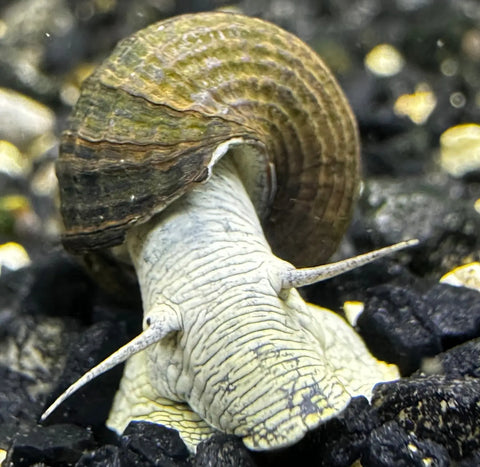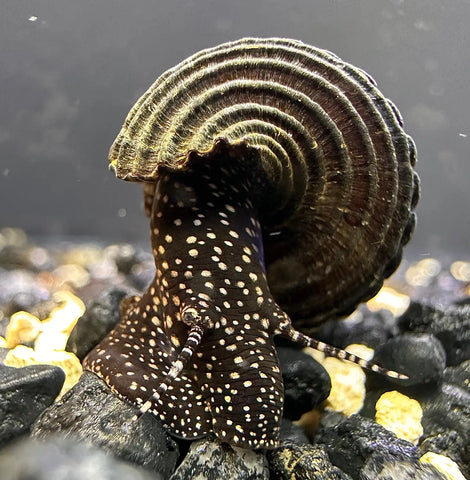There is something mesmerizing about watching a Rabbit Snail move slowly across a planted tank. With their long shells, calm nature, and unique colors, these snails bring life and motion to aquascapes without disrupting the balance. Known scientifically as Tylomelania sp., Rabbit Snails are admired by aquascapers for their beauty, gentle cleaning habits, and ability to create a peaceful underwater environment.
This guide explores why Rabbit Snails have become a favorite among aquascapers, how they fit into artistic tank designs, and what makes them such rewarding companions for freshwater enthusiasts.
What Makes Rabbit Snails Unique in Freshwater Aquariums
Rabbit Snails come from the clear lakes of Sulawesi, Indonesia, especially Lake Poso and the Malili system. Their elongated shells and soft movements make them stand out from other freshwater snails.
Each variety has its own personality and color tone, from the deep, earthy hues of the Chocolate Rabbit Snail (Tylomelania zemis) to the orange glow of the Blue Poso Rabbit Snail (Tylomelania gemmifera).
They are larger than most snails, often growing up to approximately. 4 inches, which makes them noticeable centerpieces in aquascapes. Unlike fast-moving fish, their slow pace adds a relaxing rhythm to the tank. They are peaceful, plant-safe, and can live for several years when kept in stable, clean water.
Few aquatic species match the calm elegance of Rabbit Snails as they turn ordinary tanks into tranquil living art.
Why Aquascapers Love Rabbit Snails for Natural Tank Design
Aquascaping isn’t just about how a tank looks; it’s also about how it feels. Rabbit Snails move gracefully through planted layouts, adding depth, texture, and natural contrast. Different types of Rabbit Snails fit different design styles.
The Black Rabbit Snail stands out beautifully in light or sandy tanks, adding strong contrast and depth. The Blue Poso Rabbit Snail has softer colors that blend nicely with green plants and darker layouts.
Because they stay active and visible, these snails become part of the scenery rather than hiding away. As they move, they clean surfaces and help keep the aquarium neat without disturbing plants or decorations.

Are Rabbit Snails Good for Aquarium Maintenance and Algae Control?
Yes, Rabbit Snails do more than look good; they quietly help keep the tank clean. They eat soft algae, leftover food, and bits of decaying plants, which keeps the aquarium looking fresh without the need for harsh cleaning.
They are ideal for planted tanks because they do not uproot plants or cloud the water. While they are not as fast as Nerite Snails in algae removal, they maintain cleanliness through steady, ongoing movement.
Their natural cleaning habits make them perfect for planted aquariums where both beauty and stability matter.
Rabbit Snails balance form and function, quietly maintaining water clarity while enriching the natural design of aquascapes.
How Do Rabbit Snails Behave With Other Tank Mates?
Rabbit Snails are calm and compatible with most peaceful tank residents. They get along well with shrimp, small tetras, guppies, Corydoras, and Rasboras. They move slowly and rarely compete for food, making them ideal for community aquariums.
Their behavior is curious but gentle. They explore every surface, climb driftwood, and even rest on plant leaves. Many aquascapers enjoy their expressive movement and find them fascinating to watch. Because they are non-aggressive, they add life and interest without causing stress to other inhabitants.
Caring for Rabbit Snails (Ideal Water Conditions and Diet)
Rabbit Snails are hardy and easy to maintain when basic water quality is consistent. They thrive in warm, slightly alkaline conditions that resemble their native lakes.
Ideal Parameters:
-
Temperature: 75-82°F)
-
pH: 7.5–8.5
-
Water Hardness (GH): 8–15 for shell health
-
Substrate: Fine sand or smooth gravel for burrowing
Feeding Tips:
-
Primary diet includes algae film, sinking pellets, and biofilm.
-
Supplement occasionally with blanched spinach, cucumber, or zucchini.
-
Provide calcium sources, such as cuttlebone or mineral blocks, to prevent shell thinning.
Consistency in temperature and pH is key. Stable water keeps Rabbit Snails active, healthy, and beautifully patterned.
Comparing Rabbit Snail Varieties — Black vs Blue Poso Snails
Each Rabbit Snail variety offers unique visual appeal and tank benefits. Choosing between them depends on your design style and color palette.
|
Variety |
Appearance |
Ideal Aquascape |
Behavior Notes |
|
Dark, earthy brown shell with orange body |
Minimalist or light sand aquascapes |
Active and hardy |
|
|
Olive-blue shell with golden or orange tones |
Lush, planted aquascapes |
Calm and steady grazer |
Both types are slow breeders and ideal for balanced tanks. Their personalities are subtle but engaging, making them favorites among collectors and aquascapers alike.
Why Rabbit Snails Are the Perfect Choice for Artistic Aquascaping
Rabbit Snails bring something special to the aquascaping movement, feeling alive yet calming. Their slow pace complements flowing plants, gentle lighting, and natural hardscape layouts. Unlike fish that dart around, Rabbit Snails move deliberately, creating a living-sculpture effect in the tank.
Their longevity and peaceful nature make them an excellent choice for aquarists who see their tank as more than a display; it becomes an evolving ecosystem and a work of art.
Add gentle color and personality to your aquascape with Yellow Flake Rabbit Snails or Himalayan Rabbit Snails.

FAQs
Q1: Are Rabbit Snails suitable for planted aquariums?
Yes. They eat soft algae and leftover food without harming live plants, making them perfect companions for natural and planted aquarium setups.
Q2: Do Rabbit Snails reproduce quickly?
No. They reproduce very slowly, giving birth to one or two live young at a time, ensuring the tank never becomes overcrowded or unbalanced.
Q3: What do Rabbit Snails eat?
They feed on algae, biofilm, sinking pellets, and soft vegetables like spinach or cucumber, helping maintain a naturally clean and balanced aquarium environment.
Q4: How long do Rabbit Snails live?
They usually live for 3 to 4 years in clean, stable water with adequate calcium to keep their shells strong and healthy.
Q5: Are Rabbit Snails active during the day?
Yes. They move slowly across surfaces during both day and night, constantly exploring and cleaning while adding gentle, calming movement to the aquarium.
Conclusion
Rabbit Snails are more than algae eaters; they are living design elements that elevate an aquascape’s look and balance. Their calm nature, striking colors, and gentle cleaning habits make them perfect for hobbyists who value both beauty and harmony.
If you want to create a tank that feels peaceful, natural, and full of life, start by understanding their complete care and habitat needs.
Explore Aquatic Motiv’s Rabbit Snail collection to add gentle movement, unique shell patterns, and natural balance to your underwater world.

